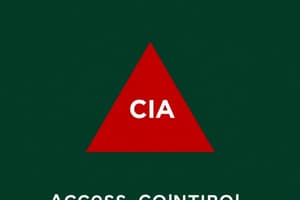Podcast
Questions and Answers
What distinguishes Discretionary Access Control (DAC) from other types of access control?
What distinguishes Discretionary Access Control (DAC) from other types of access control?
- Access decisions are based on environmental attributes.
- Access is tightly controlled by a central authority.
- Permissions can be delegated by the owner. (correct)
- Access rights are set by user roles.
Which of the following access control models focuses primarily on maintaining data integrity?
Which of the following access control models focuses primarily on maintaining data integrity?
- Clark-Wilson Model (correct)
- Chinese Wall Model
- Bell-LaPadula Model
- NIST SP 800-162
In Role-Based Access Control (RBAC), how are access permissions typically assigned?
In Role-Based Access Control (RBAC), how are access permissions typically assigned?
- By a central administrative authority.
- Based on user roles within the organization. (correct)
- According to the user's previous access history.
- Individually tailored to users' needs.
Which authorization method utilizes predefined policies for access control?
Which authorization method utilizes predefined policies for access control?
What is a key characteristic of Mandatory Access Control (MAC)?
What is a key characteristic of Mandatory Access Control (MAC)?
Which access control model is specifically designed to prevent data leaks?
Which access control model is specifically designed to prevent data leaks?
What does Attribute-Based Access Control (ABAC) utilize for making access decisions?
What does Attribute-Based Access Control (ABAC) utilize for making access decisions?
Which of the following is NOT a function of Token-Based Authorization?
Which of the following is NOT a function of Token-Based Authorization?
What principle is emphasized by the NIST SP 800-162 framework?
What principle is emphasized by the NIST SP 800-162 framework?
Which authorization method involves a network protocol that uses tickets for secure identity proofing?
Which authorization method involves a network protocol that uses tickets for secure identity proofing?
Study Notes
Types of Access Controls
-
Discretionary Access Control (DAC)
- Owner decides who can access resources.
- Permissions can be transferred (delegated) to other users.
-
Mandatory Access Control (MAC)
- Access rights are regulated by a central authority based on multiple levels of security.
- Users cannot change access permissions.
-
Role-Based Access Control (RBAC)
- Access permissions are assigned based on user roles.
- Simplifies management by grouping users with similar needs.
-
Attribute-Based Access Control (ABAC)
- Access decisions are made based on user attributes, resource attributes, and environmental conditions.
- More flexible and dynamic than RBAC.
Authorization Methods
-
Identity-Based Authorization
- Access is granted based on user identity (username/password).
-
Group-Based Authorization
- Access is granted to users belonging to specific groups (e.g., Admins, Users).
-
Policy-Based Authorization
- Uses predefined policies to determine access, often found in enterprise environments.
-
Token-Based Authorization
- Access is granted via tokens (e.g., OAuth, JWT).
- Tokens represent user permissions and are often time-limited.
-
Kerberos Authentication
- Network authentication protocol that uses tickets to allow nodes to prove their identity securely.
Access Control Models
-
Bell-LaPadula Model
- Focuses on data confidentiality.
- Implements "no read up, no write down" policy to prevent data leaks.
-
Biba Model
- Focuses on data integrity.
- Implements "no write up, no read down" policy to prevent data corruption.
-
Clark-Wilson Model
- Ensures data integrity through well-formed transactions and separation of duties.
- Enforces constraints on data manipulation.
-
Chinese Wall Model
- Prevents conflicts of interest by restricting access to information based on user’s previous access patterns.
-
NIST SP 800-162
- Framework for access control systems; emphasizes core concepts like least privilege, need-to-know, and accountability.
These mechanisms ensure that only authorized users gain access to sensitive information and resources, maintaining security and integrity within systems.
Types of Access Controls
-
Discretionary Access Control (DAC):
- Resource owners have the authority to grant or deny access to others.
- Permissions can be delegated to users by the owner.
-
Mandatory Access Control (MAC):
- Central authority regulates access permissions based on multi-level security classifications.
- Users lack the ability to alter permissions, ensuring strict control.
-
Role-Based Access Control (RBAC):
- Access assignments are based on user roles within the organization.
- Simplifies management by categorizing users with similar access needs.
-
Attribute-Based Access Control (ABAC):
- Decisions on access are made using various user and resource attributes, alongside environmental conditions.
- Provides increased flexibility and adaptability compared to RBAC.
Authorization Methods
-
Identity-Based Authorization:
- Access determined by user credentials, typically username and password.
-
Group-Based Authorization:
- Users receive access rights as part of defined groups (e.g., Administrators, General Users).
-
Policy-Based Authorization:
- Leverages established policies to dictate access; common in corporate environments.
-
Token-Based Authorization:
- Access granted through tokens (like OAuth or JWT), which signify user permissions and tend to have expiration limits.
-
Kerberos Authentication:
- Network authentication protocol that uses tickets for secure identity verification among host nodes.
Access Control Models
-
Bell-LaPadula Model:
- Prioritizes data confidentiality; implements "no read up, no write down" policy to prevent unauthorized information exposure.
-
Biba Model:
- Focuses on maintaining data integrity; enforces "no write up, no read down" to avoid corrupting data.
-
Clark-Wilson Model:
- Ensures data integrity through well-structured transactions and separation of duties.
- Establishes strict rules for data manipulation to mitigate errors.
-
Chinese Wall Model:
- Aims to prevent conflicts of interest by limiting access based on users' previous actions and access history.
-
NIST SP 800-162:
- Provides a comprehensive framework for access control systems, highlighting principles like least privilege, need-to-know, and accountability.
Summary
- Access control mechanisms are essential for safeguarding sensitive data, ensuring only authorized users can interact with critical information.
Studying That Suits You
Use AI to generate personalized quizzes and flashcards to suit your learning preferences.
Description
Explore the various types of access controls such as Discretionary, Mandatory, Role-Based, and Attribute-Based controls. Additionally, learn about authorization methods including Identity-Based and Group-Based authorization. Test your understanding of these crucial concepts in cybersecurity.




